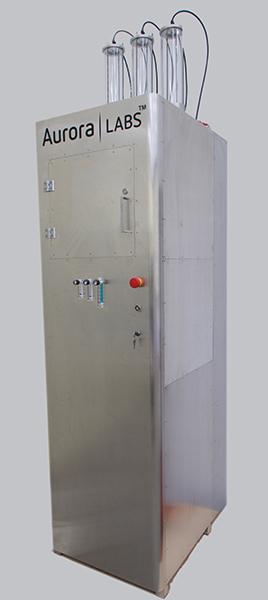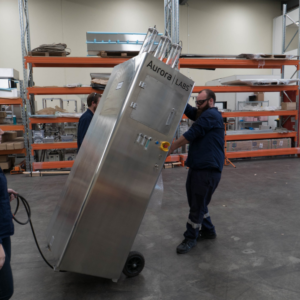 Although metal 3D printers are still quite expensive, the technology has significantly gone down in cost over the past couple of years. Not long ago, metal printers were largely unaffordable for all but the largest companies, but that’s changed as the technology continues to evolve and become more accessible. Now metal 3D printing is one of the fastest-growing sectors in the industry, and the cost of metal printers continues to drop.
Although metal 3D printers are still quite expensive, the technology has significantly gone down in cost over the past couple of years. Not long ago, metal printers were largely unaffordable for all but the largest companies, but that’s changed as the technology continues to evolve and become more accessible. Now metal 3D printing is one of the fastest-growing sectors in the industry, and the cost of metal printers continues to drop.
One of the first companies to develop an affordable metal 3D printer was Aurora Labs, which launched a Kickstarter campaign two years ago for a metal 3D printer priced below $4,000 – an unheard-of cost. Unfortunately, due to an intellectual property dispute with Kickstarter, the project ultimately fell through, but it had already raised more than three times its funding goal at the time of cancellation.
At that point, Aurora Labs moved on to the development of a large-scale metal printer that they claimed would be over 100 times faster than other machines on the market. The printer drew the interest of several large companies, as well as NASA, before its production was even completed, and now the Perth, Australia-based company has announced that they have shipped the first printer in their S-Titanium line, which includes the S-Titanium and S-Titanium Pro.
- The Aurora Labs team with their first 3D printer to ship
- [Photos: Aurora Labs via Twitter]
While the S-Titanium printers may not be under $4,000, they’re still extremely affordable for their class: the S-Titanium, which features a 200W laser, is priced at $39,999, while the S-Titanium Pro, featuring a 300W laser, costs $42,999. The patent-pending technology, according to Aurora Labs, allows for the printing of more metal materials than any other machine currently on the market. Currently available materials include Stainless Steel 316, Stainless Steel 420, Inconel 625, Inconel 718, Hastelloy C276, Stellite 1, Stellite 6, Stellite 21, NiBSi + WC60%, and Iron, and several other materials will soon be available, including Titanium Grade 1, Titanium Grade 2, Titanium Grade 4, Titanium Grade 6, Titanium Grade 12, Bronze, Brass, Gold, Silver, Aluminium AlSi7Mg, and Aluminium AlSi10Mg. The company additionally notes that third-party metal powders can be used, so long as they adhere to specific size and purity necessities.

S-Titanium Pro
Each machine is also, essentially, three printers in one, capable of printing in three modes: selective laser sintering (SLS), selective laser melting (SLM), and directed energy deposition (DED). In DED mode, on-the-fly alloying and pseudo-alloying is an option thanks to three independently controllable powder hoppers.
It’s really an incredible pair of machines, and it’s no surprise that they’ve already drawn so much interest. Aurora Labs is now gearing up for full production, and they’re already dominating the Australian Securities Exchange (ASX), despite having only been listed on August 16. They’re now the top performing IPO on the ASX, with a massive gain of 1,540% in share price as of December 9.
According to Business Insider Australia, the IT sector has taken over the IPO market, pushing resources aside as the most active capital-raising sector on the ASX. (This news comes only a day after Robo made their debut on the ASX with a $6 million IPO.) The average gain for IPOs in the IT sector was 10.6%, further emphasizing how astronomical Aurora Labs’ success is. The company is now moving into regular production, getting set to fulfill pre-orders and begin taking regular orders for their remarkable machines. Discuss in the Aurora Labs forum at 3DPB.com.
Subscribe to Our Email Newsletter
Stay up-to-date on all the latest news from the 3D printing industry and receive information and offers from third party vendors.
You May Also Like
Gorilla Sports GE’s First 3D Printed Titanium Cast
How do you help a gorilla with a broken arm? Sounds like the start of a bad joke a zookeeper might tell, but it’s an actual dilemma recently faced by...
Nylon 3D Printed Parts Made More Functional with Coatings & Colors
Parts 3D printed from polyamide (PA, Nylon) 12 using powder bed fusion (PBF) are a mainstay in the additive manufacturing (AM) industry. While post-finishing processes have improved the porosity of...
$25M to Back Sintavia’s Largest Expansion of Metal 3D Printing Capacity Since 2019
Sintavia, the digital manufacturing company specializing in mission-critical parts for strategic sectors, announced a $25 million investment to increase its production capacity, the largest expansion to its operations since 2019....
Velo3D Initiates Public Offering in a Bid to Strengthen Financial Foundations and Drive Future Growth
Velo3D (NYSE: VLD) has been among a number of publicly traded 3D printing firms that have attempted to weather the current macroeconomic climate. After posting a challenging financial report for 2023,...



































